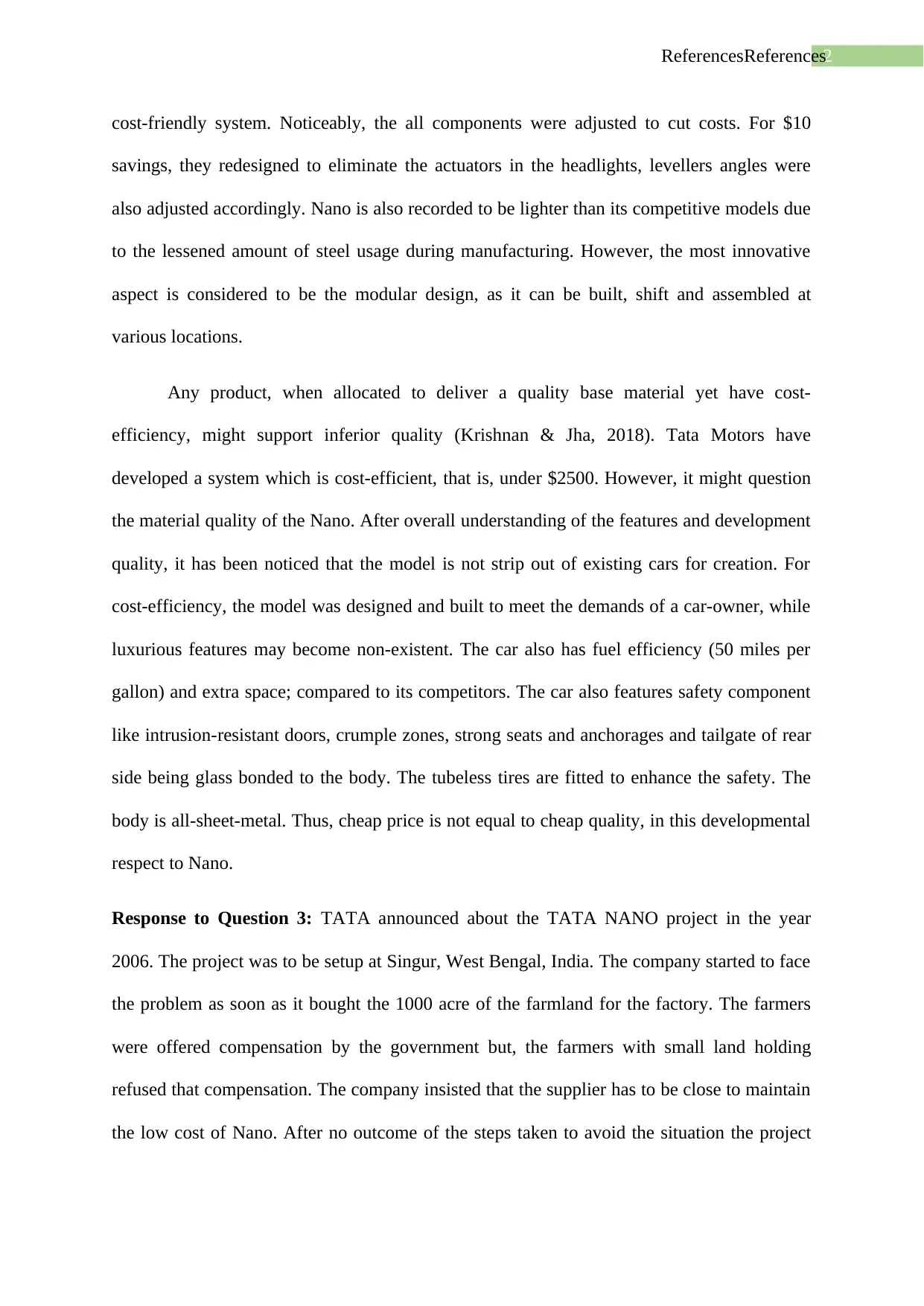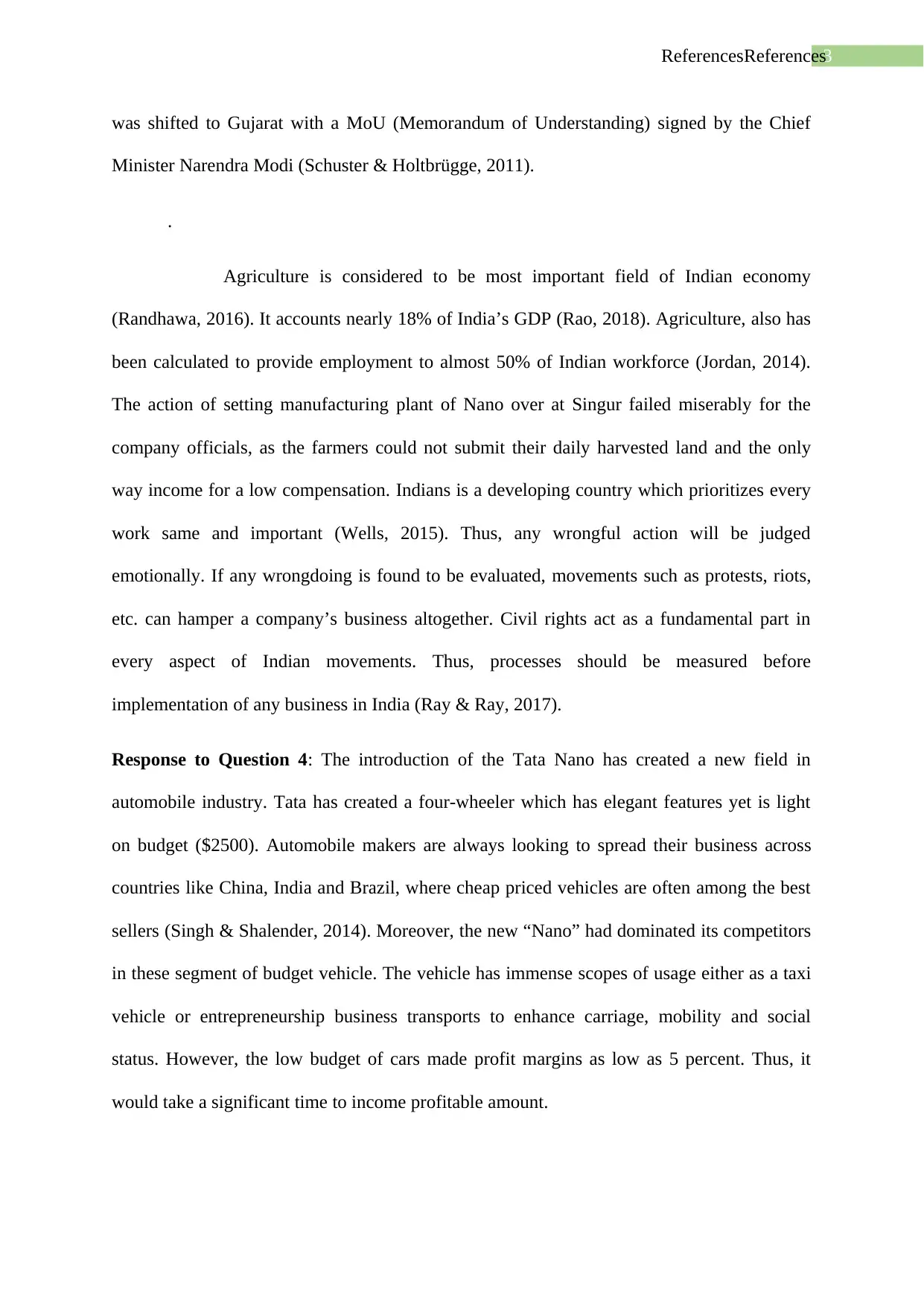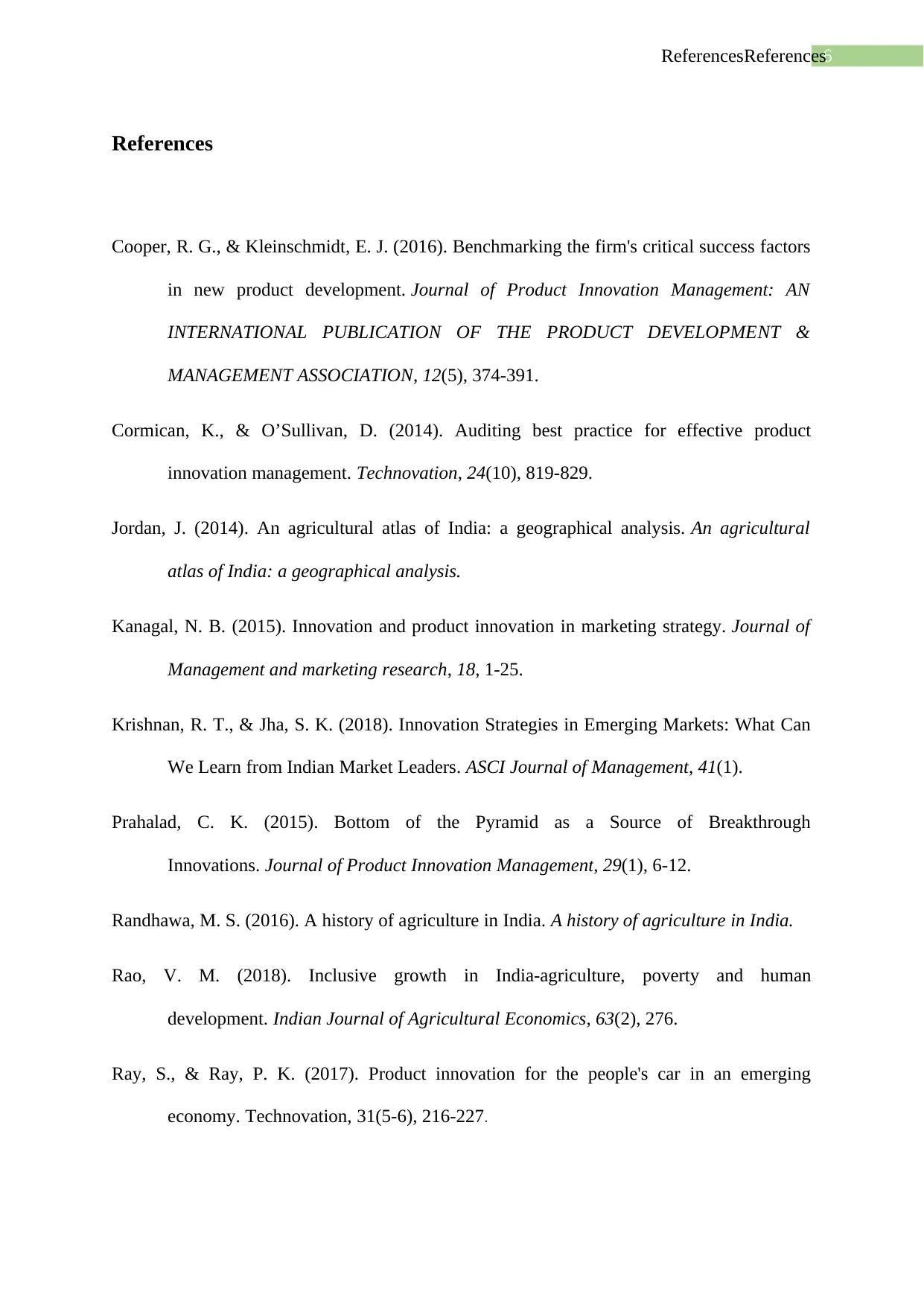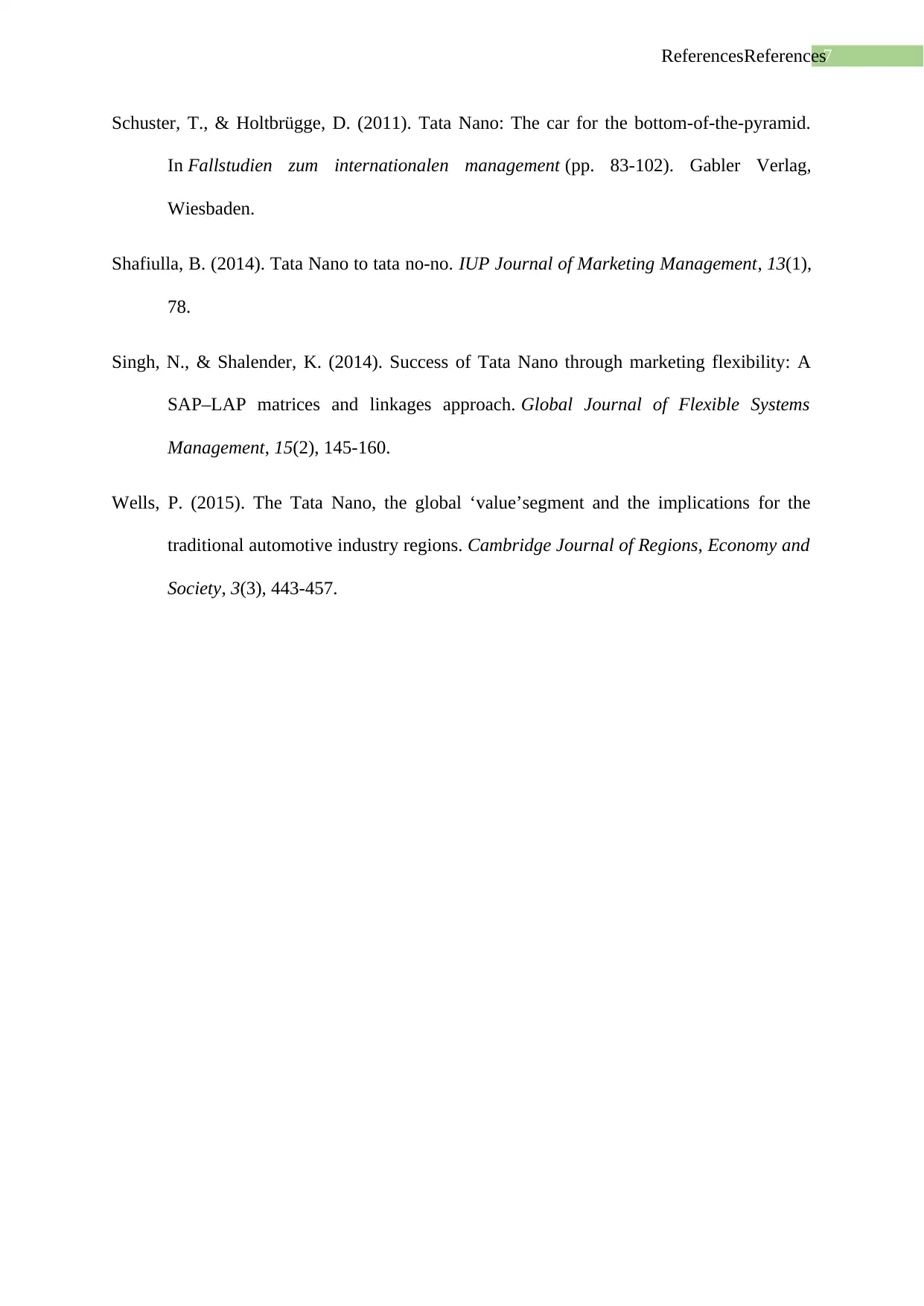Examining Tata Nano: The People's Car, Innovation and Indian Market
VerifiedAdded on 2023/04/21
|8
|2105
|293
Case Study
AI Summary
This case study delves into Tata Motors' ambitious project, the 'Nano,' aimed at revolutionizing the Indian automobile market by providing an affordable car for the lower-middle class. The case examines the strategic decisions, innovations, and challenges faced by Tata in developing and launching the Nano, including cost-cutting measures, production relocation due to land disputes, and market reception. It assesses the Nano's potential impact on the automotive industry, its competitive advantages, and the leadership role of Tata Motors in creating a low-cost vehicle. The study also explores the possibility of introducing an upgraded Nano model to developed markets like Europe and the United States, considering the necessary specifications and potential for success. The document provides a detailed analysis of the Tata Nano's journey, from its conception to its market impact, offering valuable insights into innovation, market strategy, and the challenges of serving the bottom of the pyramid.

A Case Study on: Tata “Nano”: The People’s CarA Case Study on: Tata “Nano”: The
People’s Car
A Case Study on: Tata “Nano”: The People’s Car
Name of the Student:
Name of the University:
Author Note:
People’s Car
A Case Study on: Tata “Nano”: The People’s Car
Name of the Student:
Name of the University:
Author Note:
Paraphrase This Document
Need a fresh take? Get an instant paraphrase of this document with our AI Paraphraser

1ReferencesReferences
Response to Question 1: Tata is one the reputed automobile organizations in India,
and also, around the world. In the following context, Tata is recognized to understand of
dominating the market with a mini sized car. Accordingly, similar vehicles were developed
by Volkswagen (Beetle), Ford (Model T) and British Motor Corp (Mini). These cars were
affordable and were sold to millions of customers, who were observed to struggle to afford
one. Thus, Tata new innovative idea of ‘Nano’ was designated to create a revolution in the
automobile industry (Shafiulla, 2014). The company had planning to create their global
market scene where they would be recognized as a small-car manufacturer, while delivering
these cheap products to the lower middle class (“bottom of the pyramid”) people of the
society.
According to a journal by Kanagal (2015), 49.9% population of Indian population are
employed, however 21.9% are still under national poverty line. Affording a car is a huge
investment for most in the respected nation, though the importance and comparable benefits
are clear and concise to most. In the following case, Mr. Tata also shared his experience of
watching a ride of a scooter with four members of a family. This is extremely dangerous as
any unintended accident is subjected to cause a lot of harm to all the parties, riding. Thus, it
questioned the mind of the designer to create such a vehicle which will be affordable and
convenient to Indian’s needs and requirements, and also will be light on money. Thus, the
engineers and designers, understanding the importance of such development, produced a safe,
all-weather and an affordable form of transport for the family. The car was called ‘Nano’
under Tata Motors.
Response to Question 2: Tata Nano was produced under the criteria of developing it
under $2,500, so that the price would be affordable to most of the Indian nationals. Moreover,
it requires a lot of innovation and bright ideas to produce something under a low budget.
Thus, Tata eliminated air conditioning, power brakes, radios and more features to develop the
Response to Question 1: Tata is one the reputed automobile organizations in India,
and also, around the world. In the following context, Tata is recognized to understand of
dominating the market with a mini sized car. Accordingly, similar vehicles were developed
by Volkswagen (Beetle), Ford (Model T) and British Motor Corp (Mini). These cars were
affordable and were sold to millions of customers, who were observed to struggle to afford
one. Thus, Tata new innovative idea of ‘Nano’ was designated to create a revolution in the
automobile industry (Shafiulla, 2014). The company had planning to create their global
market scene where they would be recognized as a small-car manufacturer, while delivering
these cheap products to the lower middle class (“bottom of the pyramid”) people of the
society.
According to a journal by Kanagal (2015), 49.9% population of Indian population are
employed, however 21.9% are still under national poverty line. Affording a car is a huge
investment for most in the respected nation, though the importance and comparable benefits
are clear and concise to most. In the following case, Mr. Tata also shared his experience of
watching a ride of a scooter with four members of a family. This is extremely dangerous as
any unintended accident is subjected to cause a lot of harm to all the parties, riding. Thus, it
questioned the mind of the designer to create such a vehicle which will be affordable and
convenient to Indian’s needs and requirements, and also will be light on money. Thus, the
engineers and designers, understanding the importance of such development, produced a safe,
all-weather and an affordable form of transport for the family. The car was called ‘Nano’
under Tata Motors.
Response to Question 2: Tata Nano was produced under the criteria of developing it
under $2,500, so that the price would be affordable to most of the Indian nationals. Moreover,
it requires a lot of innovation and bright ideas to produce something under a low budget.
Thus, Tata eliminated air conditioning, power brakes, radios and more features to develop the

2ReferencesReferences
cost-friendly system. Noticeably, the all components were adjusted to cut costs. For $10
savings, they redesigned to eliminate the actuators in the headlights, levellers angles were
also adjusted accordingly. Nano is also recorded to be lighter than its competitive models due
to the lessened amount of steel usage during manufacturing. However, the most innovative
aspect is considered to be the modular design, as it can be built, shift and assembled at
various locations.
Any product, when allocated to deliver a quality base material yet have cost-
efficiency, might support inferior quality (Krishnan & Jha, 2018). Tata Motors have
developed a system which is cost-efficient, that is, under $2500. However, it might question
the material quality of the Nano. After overall understanding of the features and development
quality, it has been noticed that the model is not strip out of existing cars for creation. For
cost-efficiency, the model was designed and built to meet the demands of a car-owner, while
luxurious features may become non-existent. The car also has fuel efficiency (50 miles per
gallon) and extra space; compared to its competitors. The car also features safety component
like intrusion-resistant doors, crumple zones, strong seats and anchorages and tailgate of rear
side being glass bonded to the body. The tubeless tires are fitted to enhance the safety. The
body is all-sheet-metal. Thus, cheap price is not equal to cheap quality, in this developmental
respect to Nano.
Response to Question 3: TATA announced about the TATA NANO project in the year
2006. The project was to be setup at Singur, West Bengal, India. The company started to face
the problem as soon as it bought the 1000 acre of the farmland for the factory. The farmers
were offered compensation by the government but, the farmers with small land holding
refused that compensation. The company insisted that the supplier has to be close to maintain
the low cost of Nano. After no outcome of the steps taken to avoid the situation the project
cost-friendly system. Noticeably, the all components were adjusted to cut costs. For $10
savings, they redesigned to eliminate the actuators in the headlights, levellers angles were
also adjusted accordingly. Nano is also recorded to be lighter than its competitive models due
to the lessened amount of steel usage during manufacturing. However, the most innovative
aspect is considered to be the modular design, as it can be built, shift and assembled at
various locations.
Any product, when allocated to deliver a quality base material yet have cost-
efficiency, might support inferior quality (Krishnan & Jha, 2018). Tata Motors have
developed a system which is cost-efficient, that is, under $2500. However, it might question
the material quality of the Nano. After overall understanding of the features and development
quality, it has been noticed that the model is not strip out of existing cars for creation. For
cost-efficiency, the model was designed and built to meet the demands of a car-owner, while
luxurious features may become non-existent. The car also has fuel efficiency (50 miles per
gallon) and extra space; compared to its competitors. The car also features safety component
like intrusion-resistant doors, crumple zones, strong seats and anchorages and tailgate of rear
side being glass bonded to the body. The tubeless tires are fitted to enhance the safety. The
body is all-sheet-metal. Thus, cheap price is not equal to cheap quality, in this developmental
respect to Nano.
Response to Question 3: TATA announced about the TATA NANO project in the year
2006. The project was to be setup at Singur, West Bengal, India. The company started to face
the problem as soon as it bought the 1000 acre of the farmland for the factory. The farmers
were offered compensation by the government but, the farmers with small land holding
refused that compensation. The company insisted that the supplier has to be close to maintain
the low cost of Nano. After no outcome of the steps taken to avoid the situation the project
⊘ This is a preview!⊘
Do you want full access?
Subscribe today to unlock all pages.

Trusted by 1+ million students worldwide

3ReferencesReferences
was shifted to Gujarat with a MoU (Memorandum of Understanding) signed by the Chief
Minister Narendra Modi (Schuster & Holtbrügge, 2011).
.
Agriculture is considered to be most important field of Indian economy
(Randhawa, 2016). It accounts nearly 18% of India’s GDP (Rao, 2018). Agriculture, also has
been calculated to provide employment to almost 50% of Indian workforce (Jordan, 2014).
The action of setting manufacturing plant of Nano over at Singur failed miserably for the
company officials, as the farmers could not submit their daily harvested land and the only
way income for a low compensation. Indians is a developing country which prioritizes every
work same and important (Wells, 2015). Thus, any wrongful action will be judged
emotionally. If any wrongdoing is found to be evaluated, movements such as protests, riots,
etc. can hamper a company’s business altogether. Civil rights act as a fundamental part in
every aspect of Indian movements. Thus, processes should be measured before
implementation of any business in India (Ray & Ray, 2017).
Response to Question 4: The introduction of the Tata Nano has created a new field in
automobile industry. Tata has created a four-wheeler which has elegant features yet is light
on budget ($2500). Automobile makers are always looking to spread their business across
countries like China, India and Brazil, where cheap priced vehicles are often among the best
sellers (Singh & Shalender, 2014). Moreover, the new “Nano” had dominated its competitors
in these segment of budget vehicle. The vehicle has immense scopes of usage either as a taxi
vehicle or entrepreneurship business transports to enhance carriage, mobility and social
status. However, the low budget of cars made profit margins as low as 5 percent. Thus, it
would take a significant time to income profitable amount.
was shifted to Gujarat with a MoU (Memorandum of Understanding) signed by the Chief
Minister Narendra Modi (Schuster & Holtbrügge, 2011).
.
Agriculture is considered to be most important field of Indian economy
(Randhawa, 2016). It accounts nearly 18% of India’s GDP (Rao, 2018). Agriculture, also has
been calculated to provide employment to almost 50% of Indian workforce (Jordan, 2014).
The action of setting manufacturing plant of Nano over at Singur failed miserably for the
company officials, as the farmers could not submit their daily harvested land and the only
way income for a low compensation. Indians is a developing country which prioritizes every
work same and important (Wells, 2015). Thus, any wrongful action will be judged
emotionally. If any wrongdoing is found to be evaluated, movements such as protests, riots,
etc. can hamper a company’s business altogether. Civil rights act as a fundamental part in
every aspect of Indian movements. Thus, processes should be measured before
implementation of any business in India (Ray & Ray, 2017).
Response to Question 4: The introduction of the Tata Nano has created a new field in
automobile industry. Tata has created a four-wheeler which has elegant features yet is light
on budget ($2500). Automobile makers are always looking to spread their business across
countries like China, India and Brazil, where cheap priced vehicles are often among the best
sellers (Singh & Shalender, 2014). Moreover, the new “Nano” had dominated its competitors
in these segment of budget vehicle. The vehicle has immense scopes of usage either as a taxi
vehicle or entrepreneurship business transports to enhance carriage, mobility and social
status. However, the low budget of cars made profit margins as low as 5 percent. Thus, it
would take a significant time to income profitable amount.
Paraphrase This Document
Need a fresh take? Get an instant paraphrase of this document with our AI Paraphraser

4ReferencesReferences
Nevertheless, it is mentionable to signify the leadership role of Tata among its competitors.
They created a vehicle which was called to be “the first mover advantage” by two experts
from China and India. It is meant to be a future platform than being only a present’s. The
product can be modified according to the circumstances while treating it like a group of
capabilities. On the other side, competitors mainly focus on current features, distribution
channels, customers and the branding; which limits them to be fixed in the present conditions.
Tata has shown leadership through the grasp of establishing low-cost models for Indian
market with ease while broadening their future plans (Cooper & Kleinschmidt, 2016). This is
overlooked by most companies. The company is also working on electric and hybrid versions
of the same model of Nano. Moreover, Tata shows a comprehensive advantageous position to
their rivals and are always looking for better innovation that enhances their leadership in the
market.
Response to Question 5: Nano has already been a moderate-hit in the Indian market.
Tata was approaching to a stage of introducing the same model in foreign countries. Entrance
of such car in the European and U.S. market will potentially cause financial damage for
reputed automakers like GM and Ford. The same model, which is sold for $2500 in Indian
middle-class market; could be sold in an upgraded model for nearly $8000 in the rich
European and U.S. markets. This could change the whole game for Tata’s business.
However, low cost does not fix everything in business (Cormican & O’Sullivan, 2014). In
rich countries, low budget cars are more like luxury, than a necessity (Prahalad, 2015).
However, upgradations on the model which may feel suitable to the markets of U.S and
Europe is predicted to make a better environment of sales for Tata. After a review event in
U.S., the car was justified from most critical to most optimistic viewpoints. The car needed
certain specifications which were appropriate for the foreign market, such as Luxurious feel,
more slots for objects and some of the described arguments. Again, it was also said to be
Nevertheless, it is mentionable to signify the leadership role of Tata among its competitors.
They created a vehicle which was called to be “the first mover advantage” by two experts
from China and India. It is meant to be a future platform than being only a present’s. The
product can be modified according to the circumstances while treating it like a group of
capabilities. On the other side, competitors mainly focus on current features, distribution
channels, customers and the branding; which limits them to be fixed in the present conditions.
Tata has shown leadership through the grasp of establishing low-cost models for Indian
market with ease while broadening their future plans (Cooper & Kleinschmidt, 2016). This is
overlooked by most companies. The company is also working on electric and hybrid versions
of the same model of Nano. Moreover, Tata shows a comprehensive advantageous position to
their rivals and are always looking for better innovation that enhances their leadership in the
market.
Response to Question 5: Nano has already been a moderate-hit in the Indian market.
Tata was approaching to a stage of introducing the same model in foreign countries. Entrance
of such car in the European and U.S. market will potentially cause financial damage for
reputed automakers like GM and Ford. The same model, which is sold for $2500 in Indian
middle-class market; could be sold in an upgraded model for nearly $8000 in the rich
European and U.S. markets. This could change the whole game for Tata’s business.
However, low cost does not fix everything in business (Cormican & O’Sullivan, 2014). In
rich countries, low budget cars are more like luxury, than a necessity (Prahalad, 2015).
However, upgradations on the model which may feel suitable to the markets of U.S and
Europe is predicted to make a better environment of sales for Tata. After a review event in
U.S., the car was justified from most critical to most optimistic viewpoints. The car needed
certain specifications which were appropriate for the foreign market, such as Luxurious feel,
more slots for objects and some of the described arguments. Again, it was also said to be

5ReferencesReferences
“Just good enough” car due to the no unnecessary fancy features. Moreover, the American
standards should be reviewed and evaluated to justify their upgrades according to their needs.
Then, success for the model can be strengthened.
“Just good enough” car due to the no unnecessary fancy features. Moreover, the American
standards should be reviewed and evaluated to justify their upgrades according to their needs.
Then, success for the model can be strengthened.
⊘ This is a preview!⊘
Do you want full access?
Subscribe today to unlock all pages.

Trusted by 1+ million students worldwide

6ReferencesReferences
References
Cooper, R. G., & Kleinschmidt, E. J. (2016). Benchmarking the firm's critical success factors
in new product development. Journal of Product Innovation Management: AN
INTERNATIONAL PUBLICATION OF THE PRODUCT DEVELOPMENT &
MANAGEMENT ASSOCIATION, 12(5), 374-391.
Cormican, K., & O’Sullivan, D. (2014). Auditing best practice for effective product
innovation management. Technovation, 24(10), 819-829.
Jordan, J. (2014). An agricultural atlas of India: a geographical analysis. An agricultural
atlas of India: a geographical analysis.
Kanagal, N. B. (2015). Innovation and product innovation in marketing strategy. Journal of
Management and marketing research, 18, 1-25.
Krishnan, R. T., & Jha, S. K. (2018). Innovation Strategies in Emerging Markets: What Can
We Learn from Indian Market Leaders. ASCI Journal of Management, 41(1).
Prahalad, C. K. (2015). Bottom of the Pyramid as a Source of Breakthrough
Innovations. Journal of Product Innovation Management, 29(1), 6-12.
Randhawa, M. S. (2016). A history of agriculture in India. A history of agriculture in India.
Rao, V. M. (2018). Inclusive growth in India-agriculture, poverty and human
development. Indian Journal of Agricultural Economics, 63(2), 276.
Ray, S., & Ray, P. K. (2017). Product innovation for the people's car in an emerging
economy. Technovation, 31(5-6), 216-227.
References
Cooper, R. G., & Kleinschmidt, E. J. (2016). Benchmarking the firm's critical success factors
in new product development. Journal of Product Innovation Management: AN
INTERNATIONAL PUBLICATION OF THE PRODUCT DEVELOPMENT &
MANAGEMENT ASSOCIATION, 12(5), 374-391.
Cormican, K., & O’Sullivan, D. (2014). Auditing best practice for effective product
innovation management. Technovation, 24(10), 819-829.
Jordan, J. (2014). An agricultural atlas of India: a geographical analysis. An agricultural
atlas of India: a geographical analysis.
Kanagal, N. B. (2015). Innovation and product innovation in marketing strategy. Journal of
Management and marketing research, 18, 1-25.
Krishnan, R. T., & Jha, S. K. (2018). Innovation Strategies in Emerging Markets: What Can
We Learn from Indian Market Leaders. ASCI Journal of Management, 41(1).
Prahalad, C. K. (2015). Bottom of the Pyramid as a Source of Breakthrough
Innovations. Journal of Product Innovation Management, 29(1), 6-12.
Randhawa, M. S. (2016). A history of agriculture in India. A history of agriculture in India.
Rao, V. M. (2018). Inclusive growth in India-agriculture, poverty and human
development. Indian Journal of Agricultural Economics, 63(2), 276.
Ray, S., & Ray, P. K. (2017). Product innovation for the people's car in an emerging
economy. Technovation, 31(5-6), 216-227.
Paraphrase This Document
Need a fresh take? Get an instant paraphrase of this document with our AI Paraphraser

7ReferencesReferences
Schuster, T., & Holtbrügge, D. (2011). Tata Nano: The car for the bottom-of-the-pyramid.
In Fallstudien zum internationalen management (pp. 83-102). Gabler Verlag,
Wiesbaden.
Shafiulla, B. (2014). Tata Nano to tata no-no. IUP Journal of Marketing Management, 13(1),
78.
Singh, N., & Shalender, K. (2014). Success of Tata Nano through marketing flexibility: A
SAP–LAP matrices and linkages approach. Global Journal of Flexible Systems
Management, 15(2), 145-160.
Wells, P. (2015). The Tata Nano, the global ‘value’segment and the implications for the
traditional automotive industry regions. Cambridge Journal of Regions, Economy and
Society, 3(3), 443-457.
Schuster, T., & Holtbrügge, D. (2011). Tata Nano: The car for the bottom-of-the-pyramid.
In Fallstudien zum internationalen management (pp. 83-102). Gabler Verlag,
Wiesbaden.
Shafiulla, B. (2014). Tata Nano to tata no-no. IUP Journal of Marketing Management, 13(1),
78.
Singh, N., & Shalender, K. (2014). Success of Tata Nano through marketing flexibility: A
SAP–LAP matrices and linkages approach. Global Journal of Flexible Systems
Management, 15(2), 145-160.
Wells, P. (2015). The Tata Nano, the global ‘value’segment and the implications for the
traditional automotive industry regions. Cambridge Journal of Regions, Economy and
Society, 3(3), 443-457.
1 out of 8
Related Documents
Your All-in-One AI-Powered Toolkit for Academic Success.
+13062052269
info@desklib.com
Available 24*7 on WhatsApp / Email
![[object Object]](/_next/static/media/star-bottom.7253800d.svg)
Unlock your academic potential
Copyright © 2020–2025 A2Z Services. All Rights Reserved. Developed and managed by ZUCOL.





